If your work week starts with boiling hard disks, computers overloaded with product data, stressed employees unable to make ends meet — no wonder that you’ve found this article. Yes, data management is a tricky task. Especially when it comes to managing hundreds of products in real-time across departments.
PIM solution is what eases in-house product data management. It also boosts communication across channels and prevents wasting time and money. Let’s discuss it in more detail.
What Is PIM?
A product information management (PIM) system is defined as software that processes all the data needed to market and sell products. It provides a central hub for data to help your company stay on top of all information concerning your product catalog. This includes data on attributes, product descriptions, reviews, and much more. PIM systems differ from e-commerce PDM, which is quite a broader term covering all e-commerce data being managed in one system.
A PIM solution is designed to simplify online retail for companies with large and varied inventories and sale channels. It makes this type of software particularly suitable for B2B and B2C enterprises.
PIM vs MDM vs DAM: Outlining Difference
People tend to confuse these terms — let’s figure them out.
MDM: Master Data Management is an IT tool for managing master data in a centralized repository. MDM is an essential tool adopted at the level of enterprises. It is used by e-commerce managers, retailers, suppliers, customers, and partners to interact and get up-to-date master data. MDM enhances cooperation across departments and channels and facilitates decision-making. It also optimizes operations and makes data management smarter.
DAM: Digital Asset Management allows businesses to manage digital materials like images, videos, recordings, files, and more. Digital Assent Management software is frequently used as a complementary tool for PIM. This is why you may come across various combinations and integrations of these two types of software.
PIM: Product Information Management is sometimes considered a subtype of MDM. It is also used for data synchronization across multiple domains. However, in the case of PIM, these data are mostly related to marketing and multiple sales channels. Unlike MDM, PIM solutions are mainly used by an internal team. They use it to manage all product-related information and generate insights for better marketing and sales.
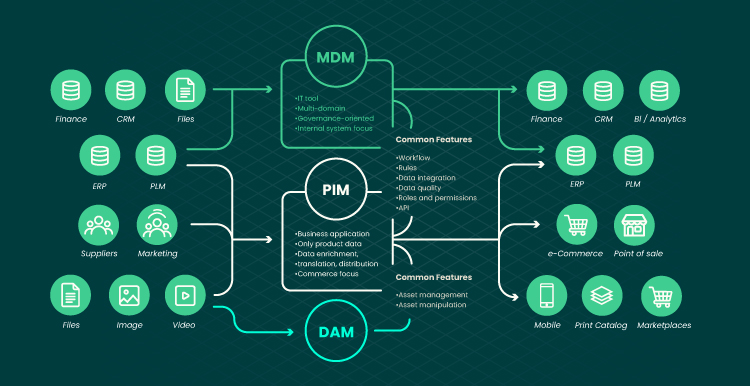
How Businesses Benefit from PIM
Retailers get many benefits after they integrate a product information management system (PIM) into their e-commerce space. Be it a third-party solution or a custom piece of software – companies are eager to invest in it. In fact, the entire PIM market is on the rise and is expected to be worth approximately $60 billion by 2027.

PIM solutions have grown in popularity. This is because businesses look for ways to be more effective and efficient. Rapid tech advancements allow them to improve and enhance the capabilities of their PIM system. This, of course, helps them provide more accurate product descriptions and the best service to their customers. And overall, PIM brings them more value. This can be seen in the following:
Enhancing time to market
The alternative to using PIM usually means working with several applications, each dedicated to a specific task. With PIM solutions, there is no need to distract your focus — you have everything needed in one place. This speeds up many processes, from adding a product to the database to presenting it to the audience. This advantage is particularly important for businesses offering exclusive and time-dependent products. PIM solution is exactly the thing that prevents your competitors from getting the products to the market faster than you.
Decreasing expenses and minimizing waste
Everybody wants to stay efficient. This means saving more resources, time, and money for making informed business decisions. When your business scales up, it becomes harder to manage hundreds of products and all product data across channels (website, social media, internal systems for communication, etc.). And when you expand product variety, the need for real-time product data management only arises. With PIM solutions, you automate workflow for the teams that work in parallel. For example, marketing teams, sales teams, and content specialists. Less time spent on a task and less waste of effort are the usual outcomes of PIM solution adoption.
By the way, if you are interested in other ideas for automation in ecommerce, check the Forbytes blog and start generating insights.
Boosting sales
Having a PIM means that you have a single system for organizing your product stories in the right way. Whenever the information about the product changes, you will not have to ask tech experts for help. You will be able to introduce updates to the website by yourself. This will set a straight connection between you and your audience. After all, a satisfied client is much more likely to return in some time.
Besides, streamlining the management of SKUs and using third-party integrations will help you make relevant product recommendations. This, in turn, will inevitably boost sales and increase client engagement.
Preventing errors and data loss
As it was said, the system stores all product data on one unified platform. It reduces e-commerce security risks and allows all stakeholders to access product data quality in real time. Cross-channel data synchronization reduces the chances of data silos. The latter may lead to in-house confusion, affect client experience, and decrease profit.
Best PIM Software: Quick Comparison
Now, you know what PIM is and how e-commerce websites use it. Let’s compare some of the best options for building a robust PIM strategy.
Akeneo PIM
Let us start with a free tool. Akeneo PIM is a global service provider in the sphere of digital commerce, retail, and product experience management. This software helps retailers organize product data across marketing channels, facilitate catalog management, and improve product distribution. Key features: accurate product data organization, rules engine, product asset management, data enrichment, data translation, rights management, and more.
These are the plans offered by Akeneo:
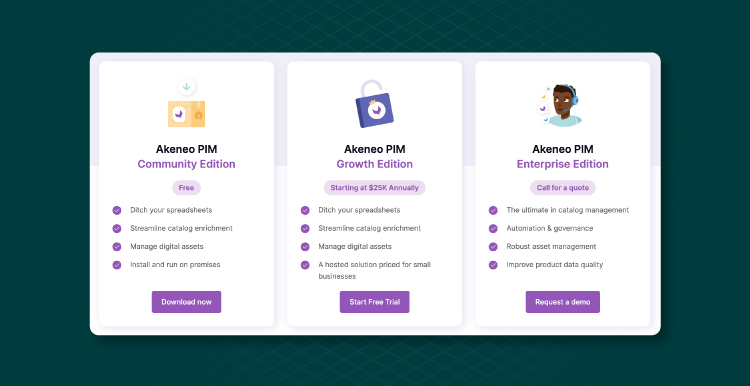
Pros: Users mention the intuitive user interface and the possibility to customize the PIM system. Akeneo is not only about product information management. This is a big ecosystem centered around product experience. The company also offers ML-powered product analytics and localization of product information.
Cons: A big drawback is a restrictive functionality for some product management aspects. For example, no automation function would allow featuring every option under editing. This complicates the mass-editing of entities.
Catsy
This tool offers PIM and e-commerce DAM services for mid-size B2B enterprises. In Catsy, businesses can automate report generation, catalog management, and data management across distribution channels. The main features include metadata tagging, product search, filters, e-commerce API, data/content completion, digital files import and export, barcode creation, etc. Catsy can be integrated with Magento, WooCommerce, Shopify, and other big e-commerce platforms.
Here is what plans Catsy has to offer:
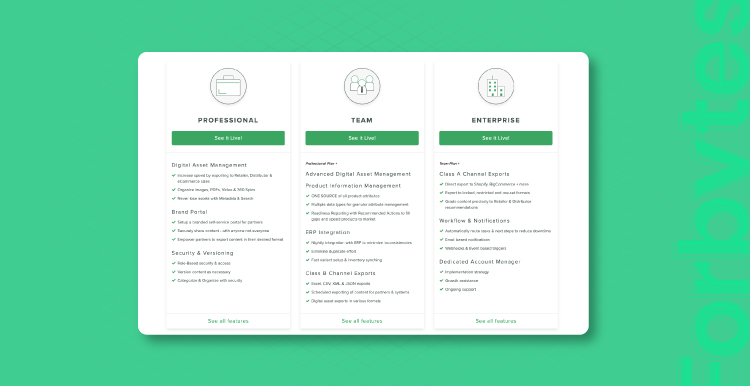
Pros: One of the benefits is robust client support that is ready to consider user requests anytime. Also, clients mention regular improvements, adding new features, product data integrity, data attribute organization, and endless capabilities of data input/output.
Cons: There is no free trial or free edition; you need to study the software via video guides to understand whether it works for your business. Also, users report that some features are not intuitive and seem to be designed more for developers than for retailers.
Plytix PIM
Plytix software is very popular among mid-size and small-size enterprises. This PIM solution has a convenient user interface and an adequate price point. The features include API, catalog creation and management, access control, asset sharing and management, categorization, and more.
Here are the plans you can opt for:
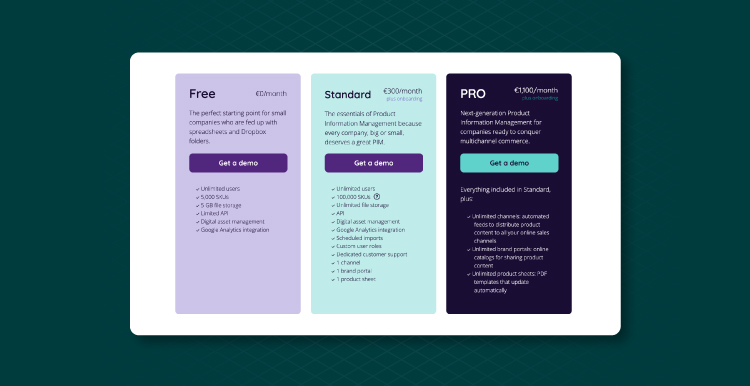
Pros: It’s easy to manage large datasets and create a rich product representation in a centralized system. Users can apply advanced filtering and add unlimited custom attributes, choosing from 13 types. You can customize the category structure and build your own relationship structure between products.
Cons: Clients report that it would be better if they had more levels of user access and could run periodic processing more often than once a day. Also, some would like to have the function of data importing via XML and the opportunity to manipulate data before the product data are fully imported to the platform.
Sales Layer PIM
If you look for an off-the-shelf Agile PIM tool, Sales Layer is what you need. This is a SaaS platform for catalog generation that can be integrated with B2B marketplaces as well as stakeholder solutions.
You can create millions of SKUs in Sales Layer, ensuring consistency and automating managerial tasks. Images, product info, and product assets are kept in one platform that is connected to multiple data sources and channels. Key features: API, customization, third-party ecommerce integrations, activity tracking, collaboration tools, and so on.
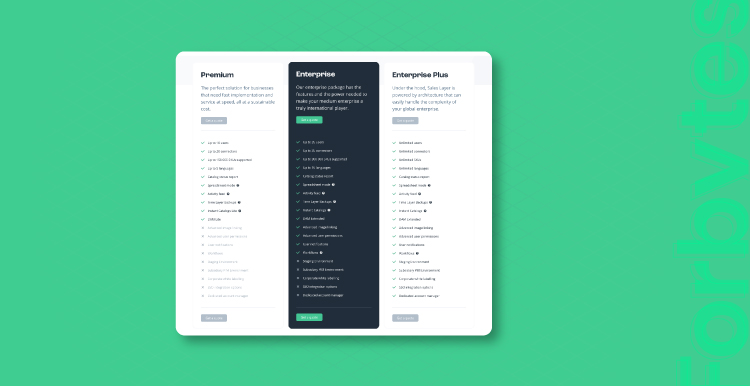
Pros: This PIM tool is visually attractive and convenient. It ensures smooth migration from the software you used before to Sales Layer PIM. Also, the tool provides robust functionality for controlling product data quality.
Cons: The management of huge catalogs is expensive; the search function could be more user-friendly. Also, some businesses report the low speed of refreshing when they use third-party tools and integrations.
Now, check the comparison of these software options based on the client reviews to decide whether you are interested:

PIM Platform: To Buy or to Build?
We’ve done our best to educate you on the topic of PIM types, benefits, and examples. As you see, popular PIM systems have pros and cons that may not always play with the specifics of your business. The question arises, should you pay for an off-the-shelf solution and compromise on the functionality? Or should you build customized software that meets all your requirements?
Before you answer this question, consider the following:
Budget
Think of what solution you prefer: a major investment for long-term benefits or regular and smaller payments for acting “here and now.”
If you choose an off-the-shelf solution, you will have to pay monthly for a subscription. On top of that, the chosen solution is likely to cover only general needs. The more customization you want, the more you will have to pay. And some of your specific needs may not be met even in the most expensive subscription plans. Before choosing this option, check the list of features you will have to pay for to see if there are the basics you need.
If you choose to build a custom software solution, you need to have a bigger budget and think long-term. The second option will be better if you already cooperate with some outsourcing team or have an expert in-house team that can be augmented by external engineers. Customized PIMs will help you build business processes in a way that is efficient and convenient exactly for you, your employees, and partners.
Time
Building software is not happening in one day. It requires a software development partner to deeply study your case and needs, prepare software requirements specification, create a project roadmap, launch development and testing, create a design, and more. This takes weeks if not months. If you have no privilege in terms of time — choose a third-party solution. Off-the-shelf software is ready to use and will only require a bit of studying on how to use it.
Most popular vendors in the PIM niche already have guidelines and video tutorials that will answer all of your questions. You will be able to start managing your products faster compared to building custom software. But if your goal is to build software with scaling in mind, then choose a custom solution.
Capacities
Your decision depends on the resources you have to collect for product information management. To build software, you need to involve a bunch of people: business analysts, UI UX designers, product managers, software engineers, and sometimes consultants. Your financial investment in the process will be accompanied by the joint effort of your whole team to build a solution tailored to your needs.
Such a decision brings more long-term value to your business. But to make this decision, your business has to be at the stage where you are ready to abstract from real-time business tasks and spend time and effort on building something bigger.
Control
If you decide to build a PIM tool, you get more control over the software. That is, your team decides on the features to be included in UI. You track software maintenance steps and can prioritize important fixes, updates, and new version releases. For this, find a software development partner that offers an Agile software development life cycle. In Agile, you are offered quality product lifecycle management. Support and maintenance are provided even after the product is built and released.
If you want to decrease the responsibility, choose an off-the-shelf solution. A third party will be responsible for all improvements and fixes, and your only duty will be to keep up with all changes and make sure that your team does the same.
Important Tips for You
In this article, we briefly answered the question “What is a PIM tool?” As you see, product information management systems tick all the boxes for an eCommerce store. They organize all product information, automate internal processes, and facilitate revenue growth. Additionally, they make both your staff and your customers happier.
But if you are determined to create custom software, do not hurry up. Building a custom solution is not that easy. No one can know the specifics of your business as deeply as you do. This is why you have to be clear about the project requirements before building a PIM solution.
As the experience shows, only practice can help businesses fully understand what functionality they need for product management. For this purpose, we advise you the following:
- Find a few PIM solutions offering a free trial. Among the tools we mentioned, Akeneo, Plytix, and Sales Layer offer the one.
- Use them for some time and compare. This will help you to understand what functionality you want to have in your custom tool.
- Identify the gaps in the software. The list of gaps will help you evaluate your product adequately after it is built (your software is supposed to have no such gaps).
- Identify the strong sides of the software. This can be used as a reference for your dedicated development team when building a custom product.
- Partner with a reliable software development vendor. Here are the tips on finding a trusted e-commerce development company. Launch a PIM solution project after agreeing upon the requirements, budget, team size, deadlines, and the rest.
Final Thoughts
In conclusion, quick facts about who we are and why we are eligible to discuss product development and product data quality. Forbytes is a software development company with offices in Europe and the US. We work with enterprises of any size and niche. We show them how the digital transformation of business can change the whole ecosystem.
Forbytes has more than 10 years of experience in e-commerce engineering, which is fully demonstrated in our portfolio. One of the examples of our work is the cooperation with Home Furnishing Nordic. The company invested in a custom PIM solution to facilitate e-commerce business processes. Together, we managed to achieve great results and ease business operations in the long run.
So, if you need help with product development or want to get expert consultation, the Forbytes team is happy to assist.

Our Engineers
Can Help
Are you ready to discover all benefits of running a business in the digital era?

Our Engineers
Can Help
Are you ready to discover all benefits of running a business in the digital era?








